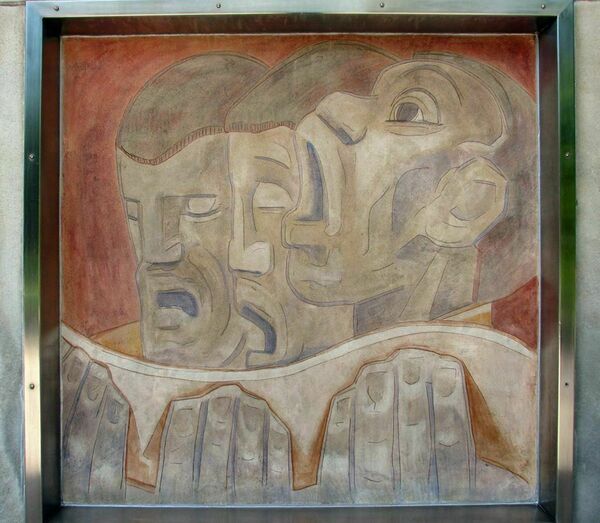
In The Silver Tassie (1929), Sean O’Casey reproduces the totalizing force of war as it relates to both the gendered male and female body. The four acts piece together the First World War by paying attention to the past, present, and future of the experience of the war. This play is interested in how we disrupt the force of war and the unavoidability of the bodily trauma that war causes. Yet, as W.B. Yeats argued in his rejection of this play, “you [O’Casey] never stood on its battlefields or walked its hospitals, and so write out of your opinions” (Yeats 1928). Yeats’ critique and rejection of The Silver Tassie further impose my reading of this play as a temporally hybrid Black-conscious representation of how sound and visuals emerge to bridge this gap between trauma and aesthetics through the transnational relationship between Irishness and Blackness. While I will not be conflating Black identity to Irish people or vice versa, the circulation of African American culture transcends space and time through the constant rhythmic vibration that people have with Blackness.
It can be said that Sean O’Casey’s early artistic life began in the rhythm of music. Even his autobiography reads more comparable to an improvised musical score than it does a typical linear autobiography. His early work and life are situated at the opening field of a certain refusal and resistance to normative ways of being, and this act of refusal is something that he shows time and time again. On the life of O’Casey’s youth days, Martin Margulies and later James Moran show that he led prayers in the protestant church he attended and that he was a “proficient reader” (Margulies 23) of the Holy Scripture. In one prayer, rather than reading verbatim from the prayer book, O’Casey improvised as he went along with his prayer. His refusal to read from the prayer book is not a rejection of the book, but an improvisation of that which is considered the predictable norm.
Considered this way, perhaps it is not a surprise to learn that O’Casey’s first introduction to drama, at least the first plays he witnessed, were melodramas from the Irish playwright Dion Boucicault. With most melodramas being accompanied by incidental music, it is no coincidence that music is so important to him. Indeed, Boucicault’s most widely known play, especially in the transnational context, was The Octoroon (1859)—a play concerned with the abolition of slavery. Though O’Casey does strongly critique melodrama as a drama form, he also states in a 1958 letter that what he took away most from melodrama was “tableau…and the ‘incidental music’ that invariably went with melodrama” (Stewart 4)). Interestingly both the tableau and the incidental music are the two most important dramaturgical elements of The Silver Tassie. Of course, music plays an important role in O’Casey’s earlier Dublin Trilogy as well; however, The Silver Tassie uses music vastly different from those plays. While Juno and the Paycock (1924) and The Plough and the Stars (1926) both include significant musical elements, the way these plays incorporate music aligns more with realistic speech and sound, as opposed to the improvisational and experimental nature of The Silver Tassie.
Similar to the assertion that O’Casey’s work begins in the rhythm of music, it can be said that most early twentieth-century modernist writers’ work begins in the rhythm of music. While this argument is not new, literary critic Oxford don Walter Pater famously argued that “art… aspires towards the condition of music” (Pater 124), my distinction between that of Pater lies in the rhythmic association of music—the kindred vibration of “joined music” (“A Bibliography of Thoreau in Music” 291) as Henry Thoreau shows. The kindred vibration I am after here is not of Thoreau’s picking at his guitar or playing of his flute, rather, the vibrations I am concerned with are regarding the improvisational Black aesthetic of Negro Spirituals. While O’Casey is interested in this improvisation of speech and sound, so too are Negro Spirituals. To think of Blackness as disrupting The Silver Tassie, the triangulation between Blackness, Black aesthetics, and Negro Spirituals must be examined.
Toward the end of this expressionist play, the Irish character Harry Heegan begins to sing, “Swing low, sweet chariot, comin’ for to carry me home…” (O’Casey 256). The Negro spiritual that emerges from Harry’s mouth elicits both a mark of separation from Irish masculinity and a social exchange between that Irishness and Blackness. This song animates Blackness by way of an auditory irruption of Black performance. The implementation of this song reimagines the spatiotemporal resistance that Blackness carries. As such, after reading this play I wondered why Black spirituals in an Irish play written during the early twentieth century. At the National Library of Ireland, a collection of letters discussing the play, along with microfilms containing unpublished articles and dissertations related to The Silver Tassie could provide new insights into the incorporation of Black musical spirituals within the works of the Irish dramatist.
The conversation between Blackness and Irishness in The Silver Tassie has been largely unnoticed, perhaps because of how brief the moment of Blackness is in the play, or perhaps because scholars note this moment as simply one of O’Casey’s many experimental musical interjections. Yet, because of O’Casey’s widely known control and authority over his plays, this inclusion of a Negro spiritual seems less arbitrary and more poetic. In the notes for The Silver Tassie, O’Casey writes that “perhaps a more

suitable Spiritual than ‘Sweet Chariot’ would be chosen for Harry to sing” (166). This statement implies that not only has he given some thought to the specific song for Harry to sing but that he had some knowledge regarding Negro Spirituals, including the importance of them and when to use them. My work seeks to elaborate on the discussion of Blackness and Irishness as they relate to masculinity through O’Casey’s use of the black radical aesthetic of music.
When I arrived at the National Library of Ireland, I was greeted with a “reader’s ticket,” which gave me access to the entirety of the library and its manuscripts. Before arriving in Ireland, I browsed through the National Library manuscript collection, with the help of its archivist, and requested specific documents to research. After receiving my reader’s ticket, the librarians had my documents waiting for me—some 12 huge folders of letters about the play and its reception. The librarian also told me about the important distinction between the reading room and the manuscript room, both places where I spent much of my time. The manuscript room had the important letters available, and the reading room had the relevant microfilms ready for me to read through. Because I had so many documents to view, I scheduled myself to review them across all three days I spent in Ireland, June 20-23.
Particularly insightful was a letter from Lady Morrell in which she tells O’Casey that she was “overcome with it…because of its beauty and tragedy.” She continues, “This is Greek Tragedy…. This is Shakespeare.”
These comments from Lady Morrell are important because few of O’Casey’s contemporaries gave him positive readings of The Silver Tassie. It is interesting to compare this play to one of Shakespeare’s tragedies, particularly Othello because of the portrayal of race in both plays. By calling this play “a beauty,” Lady Morrell is thus calling the inclusion of Negro spirituals “a beauty.” This comment is crucial due to the lack of recognition given to Black artists, especially those who made and sang these spirituals. By recognizing the beauty in this play, one recognizes the beauty in Blackness. Some other contemporaries of O’Casey sent him letters in approval of his play as well.
What is now well-known in Irish drama is that William Butler Yeats disliked The Silver Tassie very much, thinking it lacked any cohesion and that it was too experimental. Indeed, in the archives, I found numerous letters that detailed this strained relationship between Yeats and O’Casey, and I found others who disliked The Silver Tassie as well, such as the Irish dramatist and poet Lennox Robinson. More importantly, however, I found letters from St. John, who spoke positively about the experimental nature of the play. St. John said that not only would the play make money, but it was good for Irish drama to be experimental and always moving in new directions (1928, letter from St. John to O’Casey). It is also important to note that Lennox Robinson walks back his claims that the play is bad. After watching The Silver Tassie for the first time, Robinson claims, in a letter, that the “acting was bad,” but he doesn’t necessarily say that the play was bad.
One of the most important things I looked at was an unpublished article on The Silver Tassie that deals with reading and viewing the play through the lens of a “form of ritual.” This article argues that The Silver Tassie creates almost an entirely different form of experimental drama that resists aesthetic norms of expressionist drama by resisting the need for a “true” protagonist throughout the play. The writer argues that the play is, or can be seen as, a play that is always imagined with music. That is to say that the chants that happen in the play, present a play that is rarely quiet and always disruptive.
The Negro Spiritual helps to reveal the fact that Harry is self-conscious about his condition. On this relationship between condition and culture, Paul Gilroy writes, “The inescapably political language of citizenship, racial justice, and equality was one of several discourses that contributed to this transfer of cultural and political forms and structures of feeling” (Gilroy 116). For Gilroy, the linking principle between discourse, culture, and feeling, is the vernacular of music. The philosophy of Blackness was “reproduced by and through the music of the black Atlantic world” (116). Black music allows for a certain expression that can be carried over into the expression of one’s Blackness. O’Casey’s conception of Black culture might not veer too much into this thought directly, but the use of Black music does carry an expression of Blackness. O’Casey implements music into his plays, not by arbitrary means of simply having music but he carefully constructs the music to fit into the theme or idea of the play. The specific use of Negro Spirituals in The Silver Tassie not only shows readers that O’Casey was well informed of Black culture and Black expression, but it also shows that O’Casey liked them. As such, passing through this play without giving the Negro Spirituals the attention they deserve, does the play, Sean O’Casey, and the transnational relationship between Blackness and Irishness a disservice. The play must be studied under the careful examination of Blackness: it is a Black play. When studied in this way, the play helps us recognize the ubiquitous cultural effect of Blackness. Blackness exists in other cultures to bring about both discussions of trauma and the recovery of it. Emphasizing the realization of the Negro Spirituals as a work of cultural expression and not simply as a Christian awakening can help to work against this tendency to read The Silver Tassie as just an expressionist play about Irish masculinity and the war. O’Casey’s departure from Irishness by using Black songs gives readers an early account of the relationship between Irishness and Blackness.
Further recommended reading on the subject
- Baugh, John. “Specialized Lexical Marking and Alienation,” in Black Street Speech: Its History, Structure, and Survival. University of Texas Press, 2010.
- Gilroy, Paul. “Sounds Authentic: Black Music, Ethnicity, and the Challenge of a "Changing" Same.” Black Music Research Journal, vol. 11, no. 2, Fisk University, Institute for Research in Black American Music., 1991, pp. 111–36.
- Mouton Kinyon, Chanté. “Foregrounding (Lost) Rituals in the Irish and Harlem Renaissances: John Millington Synge, Zora Neale Hurston, and the Transatlantic Gesture.” Modern Drama, vol. 65, no. 4, 2022, pp. 499–521.
- Pasachoff, Naomi S. “Unity of Theme, Image, and Diction in The Silver Tassie.” Modern Drama, vol. 23, no. 1, University of Toronto Press, 1980, pp. 58–64.
- Poulain, Alexandra. “The Passion of Harry Heegan: Sean O’Casey’s The Silver Tassie.” DQR Studies in Literature, vol. 56, Brill Academic Publishers, Inc., 2015, pp. 63–75.
About the author

Zay Dale is a Ph.D. Candidate and a recipient of a University Presidential Fellowship in Humanities and Social Sciences at the University of Notre Dame. He studies black masculinity and the aesthetics of Black violence in the Early to Mid-20th Century. He is interested in examining the radical irruptions of Black violence in 20th-century texts and studies how, where, and why violence happens in these texts. Some questions that guide Zay’s research are: Do we get restorative justice through the aesthetics of Black violence? Where do the facts of Black death and fiction meet? How does the fact of Black death bleed into its fictionalization? What is the distinction between Black violent form and content in literature? Does Black death have to be qualified as a spectacle once its narrative is reclaimed by Black people? Can Black violence be understood as un/gendered? Why do we need to transmute Black death into literature? What is the distinction between violence of the flesh and violence of the skin, or violence of the physical and violence of the metaphysical?
Originally published by at eitw.nd.edu on September 14, 2023.